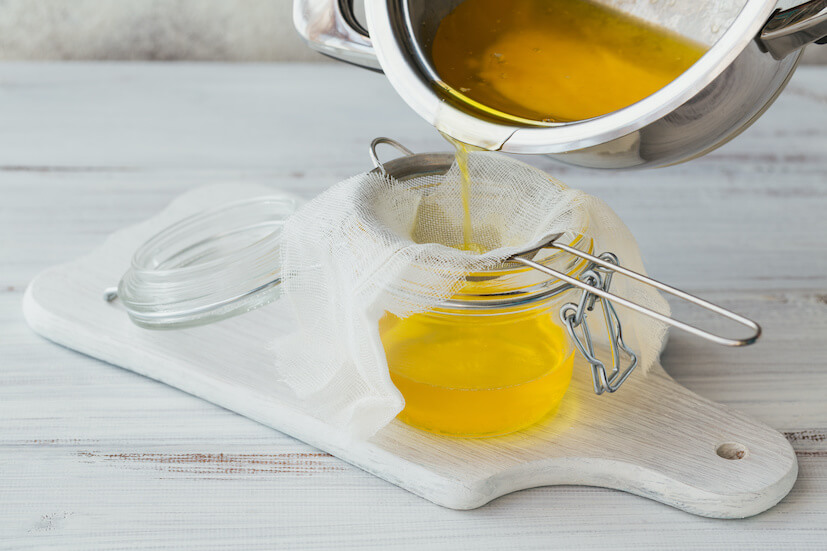How to Use Clarified Butter in Your Cooking
If you’re learning to cook, you may find “clarified butter” pop up in one of your ingredient lists. It’s tempting to brush past this new ingredient and reach for a regular stick of butter, but doing so may lead to subpar results or even a full-blown kitchen disaster. That’s because clarified butter is different from a standard stick of butter.
So what exactly is clarified butter? It’s the cooking fat that’s left behind when you remove milk solids and water from butter. Essentially, it’s pure butterfat. Due to the fat’s high smoke point and unique flavor, clarified butter has numerous uses in the kitchen.
How to Clarify Butter
Preparing clarified butter is easy, as long as you know how to do so. And since clarified butter keeps well for months, you can make a large batch to use in the coming weeks.
The goal of clarifying butter is to evaporate the water in the butter without burning the milk proteins. This means patience and proper tools are key. Before you begin the process, gather your ingredients and supplies. You’ll need unsalted butter, a saucepan, a ladle, and a piece of cheesecloth.
Place the butter in the pan and set it on a burner over medium-low heat. You can work with as little as a stick of butter, or scale up if you’d like to make a larger batch. Allow the butter to melt and then come to a simmer. As the mixture begins to simmer, the milk proteins will float to the surface and form a white foam. While you can skim off these solids with a ladle, this can cause you to lose some of the butterfat, so skim carefully.
Continue monitoring the mixture and lowering the heat if necessary. The milk proteins will eventually sink to the bottom of the pan—just make sure they don’t burn. Allow the butter to simmer until it stops bubbling. At this point, all the water has evaporated and the mixture is ready to strain through a piece of cheesecloth or coffee filter. Toss the milk proteins you’ve collected, and allow the clarified butter to cool before placing it in a sealed jar for storage.
How to Cook With Clarified Butter
Clarified butter can be used just about anywhere you would use oil but prefer a rich, buttery taste. Here are some ways you can cook with clarified butter.
Put a New Spin On Your Baked Goods
When used in baking, clarified butter adds a unique, nutty flavor. However, since clarified butter has a different composition than regular butter, you shouldn’t just swap one for the other and expect the same results. This means you should find a recipe that specifically calls for clarified butter or do some experimentation until you find a winning combination. As long as you get ingredient ratios right, clarified butter can work in cookies, bread, and sweet pastries.
Pan Fry or Sauté
One of the major advantages of clarified butter is its high smoke point. While butter has a smoke point around 350ºF, clarified butter can handle temperatures up to 450ºF. That makes it perfect for when you need to heat your food to a higher temperature but still want that buttery flavor.
The higher smoke point means the uses for clarified butter are almost endless! You can add it to a frying pan to prevent a fish filet from sticking or use it to coat a pan before you sauté onions and garlic. Clarified butter can also work for deep-fried foods like chicken and potatoes. You can also use it to coat a frying pan before you cook pancakes or french toast.
Roast Meats or Vegetables
If you’re roasting food in an oven that’s hotter than 350ºF, coating your ingredients in butter means you may end up with smoke. However, that doesn’t mean you can’t have the buttery flavor you’re looking for when you roast sweet potatoes, shrimp, or chicken. The key is to use clarified butter instead.
Since clarified butter solidifies when it’s stored at cold temperatures, you may need to heat it up to return it to liquid form. At this point, you can coat your ingredients before placing them in the oven.
Use It As a Dip for Seafood
Sure, rich seafood like crab legs and shrimp are delicious on their own. But dipping them into clarified butter only improves the flavor of these salty, briny bases. Since clarified butter is a bit more intense than regular butter, it allows you to pack a lot of flavor into each bite.
Mix Up Rich Butter Sauces
Clarified butter shines in sauces that rely on butter as one of their base ingredients and flavors. You can use it in place of regular butter in garlic-butter sauces for pasta or a lemon-butter sauce for chicken. It also works great in emulsions such as hollandaise and mayonnaise.
Clarified Butter vs. Ghee
Now that you know how to use clarified butter, you may be wondering how it compares to its cousin, ghee. Ghee and clarified butter both result after the water and milk solids are removed from butter. However, when cooks make ghee, they allow the milk solids to brown in the fat before they strain them out. This means that ghee has a nuttier flavor and darker color than clarified butter.
Continue to Explore New Ingredients
Not only are there thousands of different ingredients in the world, there are also plenty of uses for each one! That means learning about ingredients can be a long journey. While exploring in your own kitchen can help you discover new flavors and combinations you like, that’s not your only option.
Culinary school can allow students to learn from talented, experienced Chef Instructors who are passionate about both food and teaching. As students pass through Escoffier’s Culinary Arts program, they can take what they explore in earlier lessons to navigate more complex topics. So if you’re an aspiring chef, an avid home cook who wants to start a food-focused business, or a curious lifelong learner, culinary school could be for you.
This article was originally published on August 30, 2016, and has since been updated.






Recent Comments